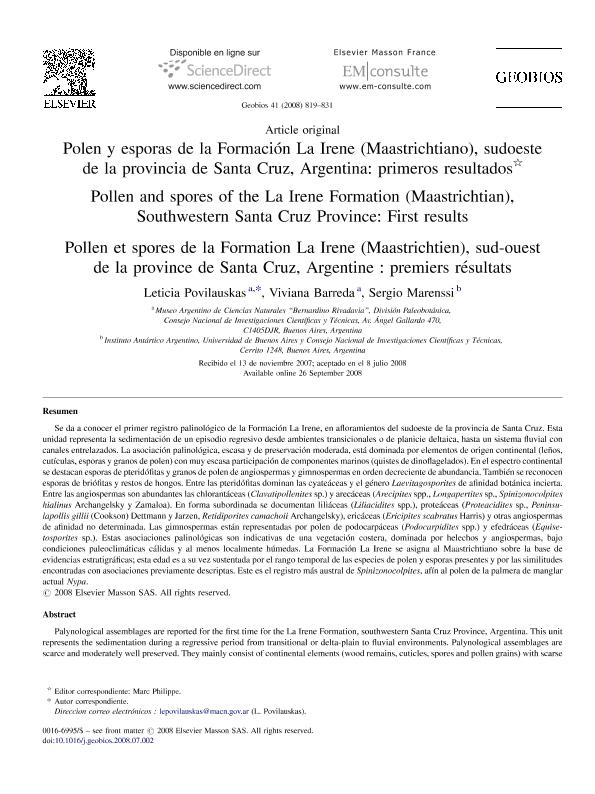Artículo
Polen y esporas de la Formación La Irene (Maastrichtiano), sudoeste de la provincia de Santa Cruz, Argentina: primeros resultados
Título:
Pollen and spores of the La Irene Formation (Maastrichtian), Southwestern Santa Cruz Province: First results;
Pollen et spores de la Formation La Irene (Maastrichtien), sud-ouest de la province de Santa Cruz, Argentine : premiers re´sultats
Pollen et spores de la Formation La Irene (Maastrichtien), sud-ouest de la province de Santa Cruz, Argentine : premiers re´sultats
Fecha de publicación:
10/2008
Editorial:
Elsevier France-editions Scientifiques Medicales Elsevier
Revista:
Geobios
ISSN:
0016-6995
Idioma:
Español
Tipo de recurso:
Artículo publicado
Clasificación temática:
Resumen
Palynological assemblages are reported for the first time for the La Irene Formation, southwestern Santa Cruz Province, Argentina. This unit represents the sedimentation during a regressive period from transitional or delta-plain to fluvial environments. Palynological assemblages are scarce and moderately well preserved. They mainly consist of continental elements (wood remains, cuticles, spores and pollen grains) with scarse marine palynomorphs (dinoflagellate cysts). The spore-pollen assemblages are dominated by fern spores, followed by angiosperm and gymnosperm pollen grains. Bryophyte spores and fungal remains are also present. Among ferns, Cyatheaceae and spores of Laevigatosporites, of uncertain affinity, are dominant. Of the angiosperm pollen, those of Chloranthaceae (Clavatipollenites sp.) and Arecaceae (Arecipites spp., Longapertites sp., Spinizonocolpites hialinus Archangelsky and Zamaloa) are the most abundant. Pollen of Liliaceae (Liliacidites spp.), Proteaceae (Proteacidites sp., Peninsulapollis gillii (Cookson) Dettmann and Jarzen, Retidiporites camachoii Archangelsky) and Ericaceae (Ericipites scabratus Harris) are also present. Gymnosperm pollen is represented by Podocarpaceae (Podocarpidites spp.) and Ephedraceae (Equisetosporites sp.). These palynological suites would represent a fern-angiosperm dominated coastal vegetation, developed under warm and at least locally humid climatic conditions. La Irene Formation is considered Maastrichtian in age based on stratigraphic evidence, which is, in turn consistent with the ages suggested by the species ranges and the similarities observed with others previously described assemblages. This is the southernmost record of Spinizonocolpites, similar to the extant mangrove palm Nypa.
Palabras clave:
LA IRENE FORMATION
,
MAASTRICHTIAN
,
PALYNOLOGY
,
SANTA CRUZ PROVINCE
Archivos asociados
Licencia
Identificadores
Colecciones
Articulos(MACNBR)
Articulos de MUSEO ARG.DE CS.NAT "BERNARDINO RIVADAVIA"
Articulos de MUSEO ARG.DE CS.NAT "BERNARDINO RIVADAVIA"
Citación
Povilauskas, Leticia Karina; Barreda, Viviana Dora; Marenssi, Sergio Alfredo; Polen y esporas de la Formación La Irene (Maastrichtiano), sudoeste de la provincia de Santa Cruz, Argentina: primeros resultados; Elsevier France-editions Scientifiques Medicales Elsevier; Geobios; 41; 6; 10-2008; 819-831
Compartir
Altmétricas




